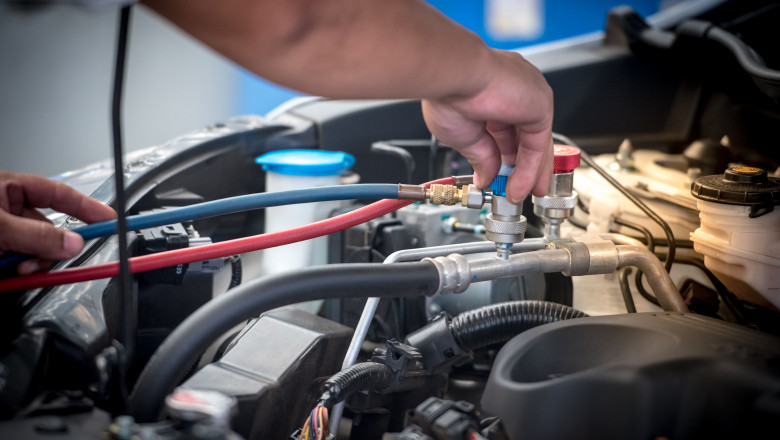views
The automotive HVAC market has evolved from a comfort-enhancing luxury to an essential component in modern vehicles. As consumer expectations shift, technology advances, and environmental regulations become stricter, HVAC systems are now integral to vehicle design, impacting energy efficiency, passenger well-being, and even vehicle performance. This comprehensive overview delves into the current state of the automotive HVAC market, highlighting key trends, driving forces, regional growth, and the innovations that are propelling this industry forward.
Expanding Role of HVAC in Modern Vehicles
Automotive HVAC systems are responsible for controlling the internal temperature, airflow, humidity, and overall air quality within a vehicle cabin. With climate change, urbanization, and health awareness on the rise, the role of HVAC systems has expanded beyond comfort to include safety and sustainability.
Consumers now demand intelligent, multi-zone systems that can automatically adjust to their preferences, detect external conditions, and improve air quality. Manufacturers are responding with increasingly sophisticated solutions—equipped with sensors, air purifiers, and automatic climate adjustments—to meet expectations for performance and efficiency across all vehicle segments, from compact cars to luxury SUVs and commercial fleets.
Key Market Drivers and Demand Factors
A primary driver of the automotive HVAC market is the global increase in vehicle production and ownership, especially in developing economies where improving living standards and extreme weather conditions are influencing buying decisions. In countries with hot or humid climates, HVAC systems are seen as necessities rather than optional features.
Another major factor is the growing adoption of electric and hybrid vehicles. Traditional HVAC systems consume a substantial amount of energy, which directly impacts the range of electric vehicles. To counter this, the market is seeing a shift toward energy-efficient HVAC technologies such as electric compressors and heat pumps that operate independently of the engine. These systems offer optimal climate control while preserving battery power—an essential requirement for EV manufacturers aiming to enhance driving range.
In addition, increasing awareness of in-cabin air quality, especially post-pandemic, is driving the demand for HVAC systems with built-in filtration, air ionization, and antibacterial capabilities. Consumers now prioritize clean and healthy air environments, particularly during long commutes or in urban areas with high pollution levels.
Impact of Environmental Regulations
Governments worldwide are enforcing stricter emissions and refrigerant usage regulations, significantly influencing HVAC system design and materials. Older refrigerants such as R-134a are being phased out in favor of low Global Warming Potential (GWP) alternatives like R-1234yf and natural refrigerants such as CO2-based systems (R-744).
These environmentally friendly options reduce the overall carbon footprint of vehicles and are rapidly gaining traction, particularly in North America and Europe, where environmental legislation is most stringent. HVAC manufacturers must now balance cost, performance, and sustainability to remain compliant and competitive in the global market.
Technological Advancements Shaping the Market
Innovation is at the heart of the automotive HVAC industry. Modern HVAC systems are increasingly integrated with smart technologies, enabling automatic control through IoT, AI, and machine learning. These systems can be controlled via smartphone apps, voice commands, or even synced with GPS to pre-condition the cabin before the journey starts.
In addition to convenience, these advancements also improve energy efficiency by tailoring HVAC usage based on the number of occupants, outside weather conditions, and historical usage patterns. Vehicles are also being equipped with sensors that monitor carbon dioxide levels and adjust airflow accordingly, maintaining a fresh and safe environment for passengers.
Furthermore, lightweight and modular HVAC components are being developed to reduce overall vehicle weight and improve fuel economy. These innovations are critical for automakers striving to meet fuel efficiency standards and reduce production costs.
Regional Market Overview
The Asia-Pacific region leads the global automotive HVAC market in terms of both production and consumption. Countries like China, India, Japan, and South Korea are home to large-scale automotive manufacturing facilities and benefit from growing domestic demand for passenger and commercial vehicles. Rising disposable incomes and rapid urbanization are further boosting HVAC system adoption.
North America and Europe continue to show strong demand, particularly in the premium and electric vehicle segments. Consumers in these regions prioritize advanced HVAC features such as dual-zone climate control, cabin pre-conditioning, and enhanced air filtration. Stringent environmental regulations also drive the rapid adoption of low-GWP refrigerants and sustainable HVAC technologies.
Meanwhile, regions like the Middle East, Latin America, and Africa are witnessing gradual market growth. The demand here is driven mainly by extreme temperatures and growing middle-class vehicle ownership. As these regions develop economically, they are expected to become significant contributors to overall HVAC market expansion.
Competitive Landscape and Market Outlook
The global automotive HVAC market is highly competitive, with several major players including Denso Corporation, Valeo SA, Hanon Systems, Mahle GmbH, and Sanden Holdings Corporation. These companies are focusing on R&D, product innovation, and strategic partnerships to enhance their global footprint.
OEMs and HVAC suppliers are increasingly working together to co-develop platform-specific HVAC solutions that can be adapted across different vehicle models. This not only reduces costs but also ensures compatibility with emerging vehicle technologies, particularly electric and autonomous platforms.
Looking ahead, the market is expected to grow steadily, supported by rising vehicle production, growing consumer demand for comfort and safety, and the global transition toward cleaner and more efficient transportation. However, challenges such as fluctuating raw material prices, supply chain disruptions, and the need for regulatory compliance will require careful navigation.
Conclusion
The automotive HVAC market stands at a pivotal point of transformation, driven by electrification, regulatory changes, and consumer expectations for comfort, health, and sustainability. This overview illustrates how HVAC systems are no longer optional features but core components that influence a vehicle’s appeal, performance, and environmental footprint.
As the market continues to evolve, innovation will remain key. Companies that invest in smart, sustainable, and energy-efficient HVAC technologies will be best positioned to capitalize on the global opportunities ahead, shaping the future of climate control in the automotive world.






















Comments
0 comment